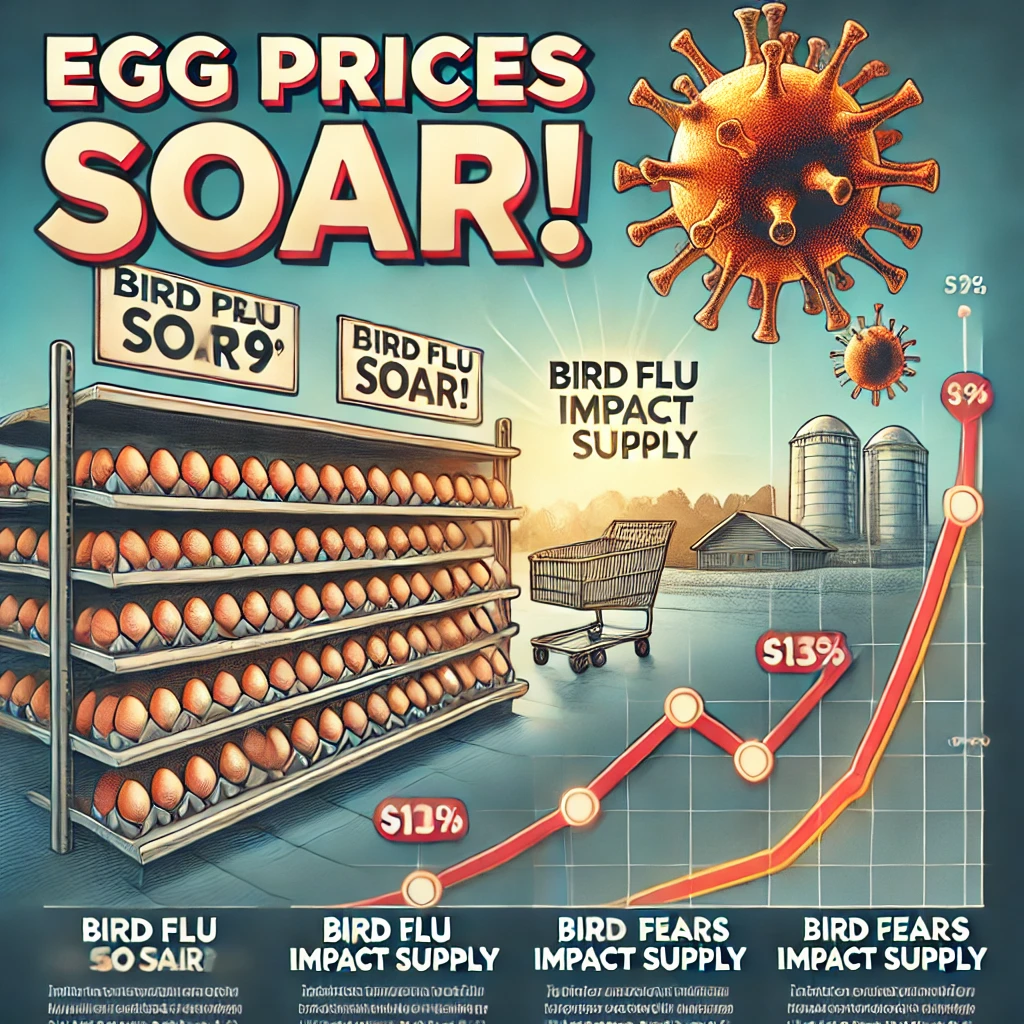
Egg Prices Soar Over Bird Flu Fears: What You Need to Know Today
Egg prices have gone through an unprecedented flood in recent weeks, and plenty of consumers are asking how their simple food product prices are rising. The main culprit? A spreading bird flu outbreak has particularly hit egg production and supply chains. In this blog, we shall discuss the reasons for this sudden spike in the prices of eggs, the boom caused by bird flu, and the effect it has on both buyers and producers.
The Surge in Egg Prices: The Curious Case of Egg Prices
You’ve seen “egg prices skyrocketing” on plenty of front pages, and with good reason. In recent months, egg prices have surged to record highs. The average price of a dozen eggs has skyrocketed from previous years, according to the U.S. Department of Agriculture (USDA). That staggering surge is largely a result of the devastating impact of bird flu on poultry farms throughout the country.
What Is Bird Flu?
Bird flu, or avian flu, is a highly contagious viral infection of domestic and wild birds. The current strain has been extremely deadly, leading to the killing of millions of chickens and turkeys in attempts to contain it. But for various reasons, these efforts, while needed, have rather effectively reduced the supply of eggs, sending the price of eggs soaring.
How Bird Flu Affects Egg Supply
The avian flu outbreak has dealt a serious blow to egg production. Over 60 million birds have been hit, according to industry estimates, with entire ranches losing their entire homes. This has left a wide gap between market supply and demand, pushing egg prices up. When egg prices soar like this, it’s not just consumers who feel the pain—the entire supply chain is affected, from farmers to retailers.
Why Are Egg Prices Soaring?
There are a number of factors driving the surge in egg prices:
Tighter Supply: The number of eggs out there has plummeted as millions of hens have been culled because of bird flu.
Higher Costs: Farmers incur greater expenses for biosecurity, labor, and feed, all of which are passed along to consumers.
Robust Demand: Eggs are a kitchen and diet staple among many households, and their versatile use in cooking ensures steady demand even when prices rise.
Seasonal Trends: Egg consumption typically surges during the holidays, which compounds the effects of supply shortages.
How Rising Egg Prices Are Impacting Consumers
When egg prices soar, consumers bear the brunt of the increase. Many families are finding it challenging to incorporate eggs into their daily meals without breaking their budgets. Many have even frequented local protein wellsprings of extract or looked for neighborhood ranchers for additional reasonable choices.
Also affected are businesses with a heavy reliance on eggs, like bakeries and restaurants, that are facing tough decisions. Few have the option not to raise menu prices or reduce production to handle increasing costs.
The International Fallout of High Egg Prices
Bird flu and rising egg prices only impact the US. The highly contagious disease is now hopping borders, so all countries face similar challenges. Egg prices have soared in Europe and Asia, too. The disease is already beginning to affect international trade as restrictions on imported poultry products and commodities are tightened.
Advice for consumers on dealing with high egg prices
How can consumers manage their grocery bills when egg prices skyrocket? Here are some practical tips:
Buy in Bulk: Sometimes buying several dozen eggs at one time can save you money.
Out for Sales: Check for sales and specials at local grocery stores.
Look for other options: substitute egg products with plant-based egg alternatives or within a protein source like lentils or tofu.
Buy From Your Local Farms: Local, small producers can sometimes be a cheaper place to buy eggs than the big retailers.
Plan meals to avoid eggs going to waste Reduce waste: Use eggs wisely and avoid letting them go to waste.
What’s Being Done to Solve the Problem?
Governments and industry stakeholders are taking steps to lessen the impact of bird flu and stabilize egg prices. Measures include:
Improved Biosecurity: Farmers are tightening protocols to stop bird flu from spreading.
Nether World: Our contribution might be through a nether world, where some poor farmer can plant crops.
1) Public Awareness Campaigns: Informing consumers about the situation could help in managing demand, thereby curbing panic buying.
The spread of avian influenza in birds had largely been contained, thanks to thorough research and the widespread vaccination of poultry in regions affected by these viruses.
A Look Ahead: What to Expect
Although the circumstances are tough, experts do anticipate egg prices will hold steady in the near term as the poultry industry rebounds. But it will take controlling the bird flu outbreak and doing right by affected communities. Until then, consumers and businesses will have to settle for the new reality of high egg prices.
Conclusion
Egg costs taking off is more than a headline; it’s a symptom of what the poultry industry and its buyers are grappling with around the world. An endemic spread of bird flu in some areas has severed supply chains and sent prices surging. By recognizing the reasons for this crisis and using practical solutions, the consumer can smoothly sail through the hard times.
As the business tries to bounce back, it’s important to keep up with the latest news. Whether you’re a shopper, entrepreneur, or simply someone interested in food trends, understanding the reasons egg prices soar—and how to adapt—makes a difference.
